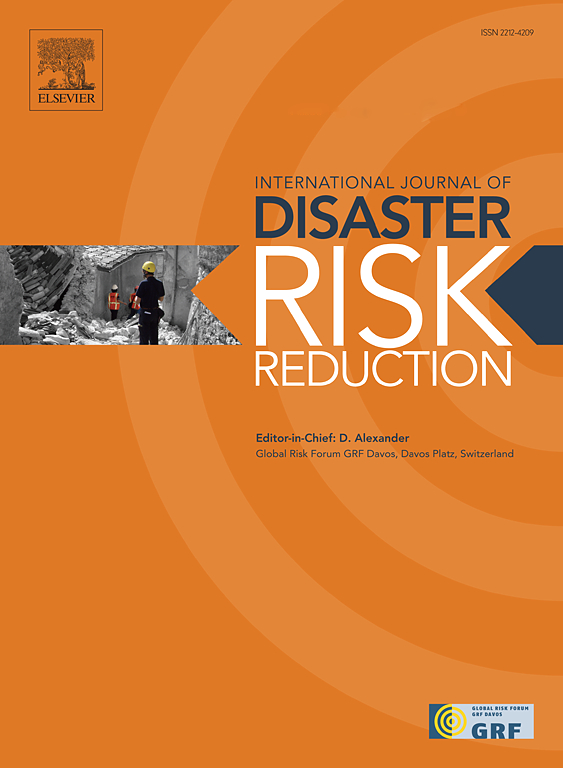老挝人民民主共和国和柬埔寨基于业务影响的洪水预警
IF 4.5
1区 地球科学
Q1 GEOSCIENCES, MULTIDISCIPLINARY
International journal of disaster risk reduction
Pub Date : 2025-07-21
DOI:10.1016/j.ijdrr.2025.105718
引用次数: 0
摘要
可操作的洪水预报和预警系统是预防灾害风险的关键工具,在世界范围内的实施率稳步上升。然而,大多数操作系统只关注检测即将到来的洪水的危害特征,而不是对社会的可能影响,这是预警中心和应急响应人员最感兴趣的变量。这项工作描述了FloodPROOFS的实施,这是一个基于物理的建模框架,用于预测柬埔寨和老挝人民民主共和国五个河流流域的河流洪水的发生及其影响。该系统每日更新两次,提供未来五天的四次数值天气预报。它使用一个模型级联来估计河流流量、水位、超过洪水阈值、淹没深度和程度、七个暴露类别的社会经济影响,包括在地区一级自动估计基于影响的警告的新方法。后者包括在与两个国家气象水文部门共同设计的警报公报应用程序中,以便在即将发生的灾害之前进行日常监测和传播警报信息。该系统将于2024年夏季投入使用,并已在提高应对一些中等规模洪水的准备工作中显示出重大价值,包括2024年7月金边附近的Prek Thnot河的洪水。本文章由计算机程序翻译,如有差异,请以英文原文为准。
Operational impact-based flood early warning in Lao PDR and Cambodia
Operational flood forecasting and early warning systems are key tools for disaster risk prevention, with implementation rates steadily increasing worldwide. Yet, most operational systems focus on detecting only the hazard characteristics of upcoming floods, rather than the likely impacts on the society, which are the variables of highest interest for warning centers and emergency responders. This work describes the implementation of FloodPROOFS, a physically based modelling framework to predict the occurrence and the consequent impacts of riverine floods in five river basins in Cambodia and in Lao People's Democratic Republic. The system is updated twice daily with four numerical weather predictions for the next 5 days. It uses a modeling cascade to produce estimates of river discharges, water levels, exceedance of flood thresholds, inundation depth and extent, socio-economic impacts for seven exposure categories, including a novel approach for the automated estimation of impact-based warnings at the district level. The latter are included in a warning bulletin application co-designed with the two national meteo-hydrological services for daily monitoring and dissemination of alert messages ahead of impending disasters. The system is operational from summer 2024 and has already shown significant value in rising preparedness ahead of some moderate-magnitude floods, including the floods of the Prek Thnot river near Phnom Penh in July 2024.
求助全文
通过发布文献求助,成功后即可免费获取论文全文。
去求助
来源期刊

International journal of disaster risk reduction
GEOSCIENCES, MULTIDISCIPLINARYMETEOROLOGY-METEOROLOGY & ATMOSPHERIC SCIENCES
CiteScore
8.70
自引率
18.00%
发文量
688
审稿时长
79 days
期刊介绍:
The International Journal of Disaster Risk Reduction (IJDRR) is the journal for researchers, policymakers and practitioners across diverse disciplines: earth sciences and their implications; environmental sciences; engineering; urban studies; geography; and the social sciences. IJDRR publishes fundamental and applied research, critical reviews, policy papers and case studies with a particular focus on multi-disciplinary research that aims to reduce the impact of natural, technological, social and intentional disasters. IJDRR stimulates exchange of ideas and knowledge transfer on disaster research, mitigation, adaptation, prevention and risk reduction at all geographical scales: local, national and international.
Key topics:-
-multifaceted disaster and cascading disasters
-the development of disaster risk reduction strategies and techniques
-discussion and development of effective warning and educational systems for risk management at all levels
-disasters associated with climate change
-vulnerability analysis and vulnerability trends
-emerging risks
-resilience against disasters.
The journal particularly encourages papers that approach risk from a multi-disciplinary perspective.
 求助内容:
求助内容: 应助结果提醒方式:
应助结果提醒方式:


